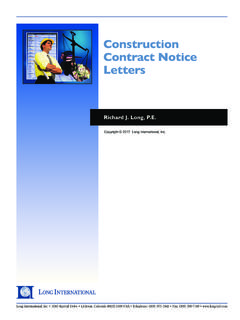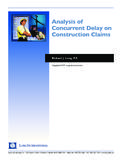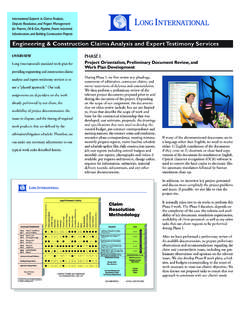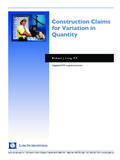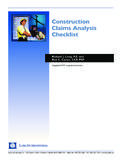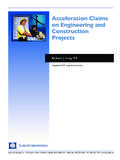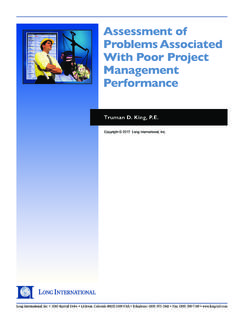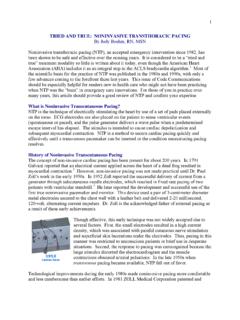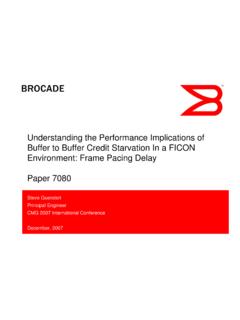Transcription of Ronald J. Rider, MBA and Richard J. Long, P.E.
1 LONG Skytrail DriveLittleton, Colorado 80123 -1566 USAT elephone: (303) 972 - 2443 Fax: (303) 200 -7180 Long International, Inc. Ronald J. Rider, MBA andRichard J. Long, of Concurrent/ pacing Delays Ronald J. Rider, MBA and Richard J. Long, Table of Contents 1. INTRODUCTION .. 1 2. CONCURRENT/ pacing DELAY CONCEPTS DEFINED .. 2 3. AN OWNER S PERSPECTIVE .. 6 4. A CONTRACTOR S PERSPECTIVE .. 8 5. INDUSTRY PRACTICE .. 10 6. ANALYSIS OF COMMON CONTRACT REQUIREMENTS .. 11 7. ANALYSIS OF RELEVANT CASE LAW .. 13 FAVORABLE CONTRACTOR RULINGS .. 13 FAVORABLE OWNER RULINGS .. 15 8. EFFECTS OF CONCURRENT pacing DELAYS .. 17 9. STEPS REQUIRED TO PROVE CONCURRENT/ pacing DELAYS .. 18 List of Tables Table 1 Net Effect of pacing Delays .. 5 List of Figures Figure 1 Direct pacing .. 3 Figure 2 Indirect pacing .. 4 Copyright 2017 Long International, of Concurrent/ pacing Delays 1. INTRODUCTION Basic chemistry has taught us that gas expands to fill available space.
2 In the construction industry, this fundamental principle has transformed into the adage that work expands to fill available time. Therefore, it is not unusual for an owner-caused critical path delay to extend the performance of other concurrent contractor work activities. When a contractor seeks compensation for the owner delay, an owner s typical assessment is that the delays to the other work are concurrent delays caused by the contractor, and therefore, no extended general conditions or home office overhead damages are compensable. Owners are typically not liable to pay for delay costs that they have caused if contractor-caused concurrent delays exist, but they are often liable to provide a time extension, either through express contract language or implied through industry practice. To counter the owner s argument regarding concurrent delay being noncompensable, contractors proclaim that the alleged concurrent delays were really not independent delays but instead were dependent delays that were the result of work keeping pace with the delays caused by the owner.
3 The contractor s rationale is, Why should I hurry up and then wait? Hence, an excuse called pacing emerged. Many contractors, however, fail to adequately prove that contractor pacing was the sole reason behind intentional, concurrent delays that were directly caused by the owner s critical path delays. Also, courts have been inconsistent in their treatment of this particular concurrent delay issue. This article attempts to define, research, and analyze the concept called pacing relative to owner-caused delays as well as explain the necessary steps to adequately demonstrate that pacing is not a concurrent contractor-caused delay. Copyright 2017 Long International, of Concurrent/ pacing Delays 2. CONCURRENT/ pacing DELAY CONCEPTS DEFINED The concepts of concurrent delays and pacing delays are similar. Concurrent delays are generally defined two or more parallel and independent delays to the critical path on a project.
4 Some people argue that a concurrent delay must be on the same critical path. Others argue that a concurrent delay may exist on a parallel critical path. Even further, some argue that the concurrent delay has to start on the same day, because otherwise, the first delay creates float in the schedule that the second delay merely absorbs. By using a But-For test for concurrent delay, if one of the concurrent delays is absent, the argument is that the other concurrent delay would still have extended the project finish. As for any type of delay, the key aspect to concurrent delays is determining which party is responsible for the delay. Generally, case rulings have acknowledged that two simultaneous, independent, concurrent critical path delays, one caused by the owner and the other caused by the contractor, have provided the contractor with only entitlement to a time extension to the project This issue was discussed in a decision by the Veteran s Administration Board of Contract Appeals, as follows: The general rule is that, where both parties contribute to the delay, neither can recover damages, unless there is in the proof a clear apportionment of the delay and expense attributable to each party.
5 Courts will deny recovery where the delays are concurrent and the contractor has not established its delay apart from that attributable to the Under certain conditions, however, some case rulings have allowed contractors to receive both a time extension and recovery of delay-related costs when an owner caused a delay to the critical path and the contractor has a simultaneous delay. A contractor can be merely pacing the work by utilizing the available float caused by the owner These cases are few and, needless to say, the pacing argument may be highly questionable. Contractors have argued that the reason for a concurrent contractor-caused delay, or pacing delay, was the result of a management decision not to hurry up and then wait because the owner-caused delay was driving the project completion. Simply said, pacing has emerged as an excuse to explain why a contractor decided to stretch-out its work to keep pace to the cadence of other work that is more critical.
6 1 Cogefar-Ipresit , Inc., DOTBCA No. 2721, 97-2 BCA 29,188 at 145,207; Freeman-Darling, 89-2 BCA 21,882 at 110,100. 2 Coffey Construction Company, Inc., VABCA No. 3361, 93-2 BCA 25, 788 (1993). 3 Tyger Constr. Co. v. United States, 31 Fed. Cl. 177 (Fed. Cl. 1994); Jay P. Altmayer, GSBCA No. 12639. 95-1 BCA 27,515 at 137,122-23; H&S Corp., ASBCA No. 29,688. 89-3 BCA 22,209 at 111,720-21. Copyright 2017 Long International, of Concurrent/ pacing Delays pacing delay occurs when the delay in one activity occurs, and a conscious and contemporaneous decision is made by the contractor to pace progress in a second and independent activity, or several activities. Thus, the contractor deliberately slowed down its work in the second activity because of the delay to the first activity. However, concurrent delay results when the work in a second and independent activity, or several activities, is involuntarily delayed by factors independent of any problems arising from the delay in another activity.
7 pacing is typically manifested in two distinct circumstances. 1. One situation, called direct pacing , is where the duration of a successor schedule activity is extended due to a delay in a predecessor activity on which the progress of the successor activity is directly dependent. As shown in Figure 1, the duration of the wire pulling work is extended in duration because the installation of conduit work is taking longer due to the lack of conduit material. While this is pacing , it is not considered a concurrent delay the cause of one delay is the result of the other delay. Examination of activity relationships in the schedule, usually in the form of finish-to-finish ties, will provide the information to determine if direct pacing has occurred. Figure 1 Direct pacing Copyright 2017 Long International, of Concurrent/ pacing Delays 2. In the second situation, called indirect pacing , the paced activity has no dependency on the other activity.
8 As shown in Figure 2, the contractor deliberately slows down its piping installation work in Unit B because of the owner s delay in equipment delivery in Unit A. The equipment delivery delay creates4 available float to be consumed by the piping installation in Unit B activity. Figure 2 Indirect pacing 4 The term creation should not be interpreted to mean that total float is increased. In fact, the opposite is true. The parent delay adversely impacts the overall critical path of the project, thereby decreasing total float. What it creates (increases) is relative total float on the path of the paced activity relative to the total float on the path carrying the parent delay. Copyright 2017 Long International, of Concurrent/ pacing Delays pacing can be a defense to a potential concurrent delay and it is not a distinct delay event.
9 Therefore, the pacing issue is relevant only to the extent that concurrency of delays is an issue. Unless contractually stipulated otherwise, on most projects the contractor s right to pace its work is accepted along with the view that float is a shared resource that is to be used by the party who first needs the float. However, lack of resources which should have been provided by the contractor, or poor productivity that was caused by the contractor and which caused other independent activities to be delayed, are not considered pacing delays. These are contractor-caused problems, and the contractor is responsible for the delay and disruption that are caused by these problems. pacing may alter the net effect of the compensability of a concurrent delay situation, as shown in Table 1 below: Table 1 Net Effect of pacing Delays Delay Event Concurrent With Net Effect Owner Delay Contractor pacing Compensable to Contractor, Non-excusable to Owner Owner pacing Another Contractor Delay or Nothing Non-Excusable to Contractor, Compensable to Owner Copyright 2017 Long International, of Concurrent/ pacing Delays 3.
10 AN OWNER S PERSPECTIVE For an owner, the inability to timely utilize a project for its intended purposes could have costly affects to an owner s operation. Delays may cause owners to incur unanticipated costs such as: Governmental fines and penalties Additional rental expenses Interest charges Third party claims Missed market penetration Loss of revenue from operations Reduction of shareholder equity Loss of key resources (staffing & equipment) Normally, owner contracts attempt to allocate many of the above risks by including provisions for liquidated damages to be assessed against the contractor for not completing the work in accordance with contract s completion date. When an owner delays the critical path, and other work is also delayed based on a contractor s excuse that it is pacing its work, the owner should be highly skeptical. The pacing argument is easy to assert, but it can be difficult to defend.
